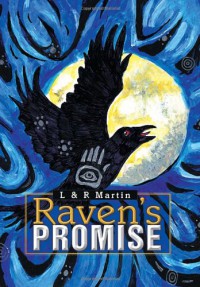
The Powerful Magic of Childhood

Three intrepid, resilient kids learn to harness the elements and save themselves in this appealing fantasy for children who have suffered trauma.
Open the richly illustrated cover of Raven’s Promise and enter the magical world created by sisters and co-authors Laura and Ruth Martin. Teachers as well as writers, the Martins offer inspiring allegorical lessons for tweens and teens who have survived childhood traumas. Shape-shifting panthers, eagles, and deer populate the mystical realm of Raven, where a trio of troubled children travels to heal their real-life emotional wounds.
The line between reality and fantasy is thin from the beginning, where readers find ten-year-old Sheila imprisoned by Marcella, a wicked stepmother if ever there was one. Marcella has turned Sheila’s own father against her, convincing him that his imaginative daughter is mentally ill and should be placed in a hospital. Luckily for Sheila, the hospital in question is not the sterile asylum she pictures but an unusual place filled with ancient books, symbol-covered rugs that seem to glow, and a doctor who sings more than he talks.
It’s also home to her new friends, Snapper and Pen, whose quirky personalities add life and dimension to the story. Snapper, aka Molly, is a “walking encyclopedia,” a fountain of academic knowledge who is desperately afraid of being alone. Pen, officially named Stephan, can’t utter a word but offers his thoughts in writing. All three have suffered grievous losses in their young lives but are amazingly resilient, as their otherworldly adventures will soon prove to them.
Across a mysterious gate they go, to enter Raven’s world, where they embark on a quest to save three children from the clutches of an evil witch. It’s clear that they are also facing their own demons, and thus saving themselves in the process. For the most part, the Martins vividly show each child’s individual journey. Sheila learns to fly and eventually soar as a raven, for instance, sensing true freedom for the first time.
Sometimes, though, the authors reinforce their underlying messages a little too emphatically, offering asides that address the reader directly or comparing magical events to “real life,” thus breaking the illusion of the otherwise engaging fantasy world.
Young readers will enjoy going along with these three intrepid kids as they learn to harness the elements and save themselves, although teenagers raised on Harry Potter may find this short novel lacking in the deep character and plot development they have come to expect.
Raven’s Promise could also be read to groups of younger children and seems likely to be an excellent tool to use in children’s therapy, where the adult reader could pause and encourage a young patient to talk about the issues raised.
Laura and Ruth Martin have written a modern fable with multiple levels of meaning, making Raven’s Promise an appealing fantasy for a wide range of ages.
Sheila M. Trask for ForeWord Reviews
July 10, 2013



